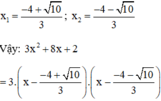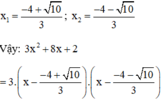Hãy nhập câu hỏi của bạn vào đây, nếu là tài khoản VIP, bạn sẽ được ưu tiên trả lời.


Bài 5:
a. 1 - 2y + y2
= (1 - y)2
b. (x + 1)2 - 25
= (x + 1)2 - 52
= (x + 1 - 5)(x + 1 + 5)
= (x - 4)(x + 6)
c. 1 - 4x2
= 12 - (2x)2
= (1 - 2x)(1 + 2x)
d. 8 - 27x3
= 23 - (3x)3
= (2 - 3x)(4 + 6x + 9x2)
e. (đề hơi khó hiểu ''x3'' !?)
g. x3 + 8y3
= (x + 2y)(x2 - 2xy + y2)

\(x^2-x+1-m=0\left(1\right)\\ \text{PT có 2 nghiệm }x_1,x_2\\ \Leftrightarrow\Delta=1-4\left(1-m\right)\ge0\\ \Leftrightarrow4m-3\ge0\Leftrightarrow m\ge\dfrac{3}{4}\\ \text{Vi-ét: }\left\{{}\begin{matrix}x_1+x_2=1\\x_1x_2=1-m\end{matrix}\right.\\ \text{Ta có }5\left(\dfrac{1}{x_1}+\dfrac{1}{x_2}\right)-x_1x_2+4=0\\ \Leftrightarrow5\cdot\dfrac{x_1+x_2}{x_1x_2}-x_1x_2+4=0\\ \Leftrightarrow\dfrac{5}{1-m}+m-1+4=0\\ \Leftrightarrow\dfrac{5}{1-m}+m+3=0\\ \Leftrightarrow5+\left(1-m\right)\left(m+3\right)=0\\ \Leftrightarrow m^2+2m-8=0\\ \Leftrightarrow m^2-2m+4m-8=0\\ \Leftrightarrow\left(m-2\right)\left(m+4\right)=0\\ \Leftrightarrow\left[{}\begin{matrix}m=2\left(n\right)\\m=-4\left(l\right)\end{matrix}\right.\)
Vậy $m=2$

Vì \(x_1\) là nghiệm PT nên \(x_1^2+3x_1-7=0\Leftrightarrow x_1^2=7-3x_1\)
\(F=x_1^2-3x_2-2013=7-3x_1-3x_2-2013\\ F=-3\left(x_1+x_2\right)-2006\)
Mà theo Viét ta có \(x_1+x_2=-3\)
\(\Rightarrow F=\left(-3\right)\left(-3\right)-2006=-1997\)

a,\(\left(x^2+x\right)2+3\left(x^2+x\right)+2\)
=\(\left(x^2+x\right)6+2\)
b,\(\left(x^2+x\right)2-2\left(x^2+x\right)-15\)
=\(-4\left(x^2+x\right)-15\)
c,\(\left(x^2+x+1\right)\left(x^2+x+2\right)-12\)
=\(\left(x^2+x+1\right)\left(x^2+x+1\right)+1-12\)
=\(\left(x^2+x+1\right)^2-11\)
d,\(\left(x^2+x\right)2+4x^2+4x-12\)
=\(x\left(x+1\right)2+2x\left(x+1\right)-12\)
=\(2x\left(x+1\right)+2x\left(x+1\right)-12\)
=\(\left(x+1\right)\left(2x+2x-12\right)\)
= \(\left(x+1\right)\left(4x-12\right)=4\left(x+1\right)\left(x-3\right)\)
e,\(\left(x^2+2x\right)2+9x^2+18x+20\)
=\(x\left(x+2\right)2+9x\left(x+2\right)+20\)
=\(2x\left(x+2\right)+9x\left(x+2\right)+20=\left(x+2\right)\left(2x+9x+20\right)\)
=\(\left(x+2\right)\left(11x+20\right)\)

3x2 + 8x + 2 = 0
Có a = 3; b' = 4; c = 2
⇒ Δ’ = 42 – 2.3 = 10 > 0
⇒ Phương trình có hai nghiệm phân biệt:


* Chứng minh:
Phương trình a x 2 + b x + c = 0 có hai nghiệm x 1 ; x 2
⇒ Theo định lý Vi-et: 
Khi đó : a.(x – x1).(x – x2)
= a.(x2 – x1.x – x2.x + x1.x2)
= a.x2 – a.x.(x1 + x2) + a.x1.x2
= 
= a . x 2 + b x + c ( đ p c m ) .
* Áp dụng:
a) 2 x 2 – 5 x + 3 = 0
Có a = 2; b = -5; c = 3
⇒ a + b + c = 2 – 5 + 3 = 0
⇒ Phương trình có hai nghiệm 
Vậy: 
b) 3 x 2 + 8 x + 2 = 0
Có a = 3; b' = 4; c = 2
⇒ Δ ’ = 4 2 – 2 . 3 = 10 > 0
⇒ Phương trình có hai nghiệm phân biệt:

a, \(=x^3-4x+x^2+4x+4=x\left(x-2\right)\left(x+2\right)+\left(x+2\right)^2\)
\(=\left(x+2\right)\left[x\left(x-2\right)+x+2\right]=\left(x+2\right)\left(x^2-x+2\right)\)
b, \(=2x^3-x^2-2x^2+3x-1=x^2\left(2x-1\right)-\left(x-1\right)\left(2x-1\right)\)
\(=\left(2x-1\right)\left(x^2-x+1\right)\)
c, \(=x^4+x^3+x^3+x^2+x+1=x^3\left(x+1\right)+x^2\left(x+1\right)+x+1\)
\(=\left(x+1\right)\left(x^3+x^2+1\right)\)
Em không hiểu câu b chị có thể giải thích đc không ạ.Em cảm ơn